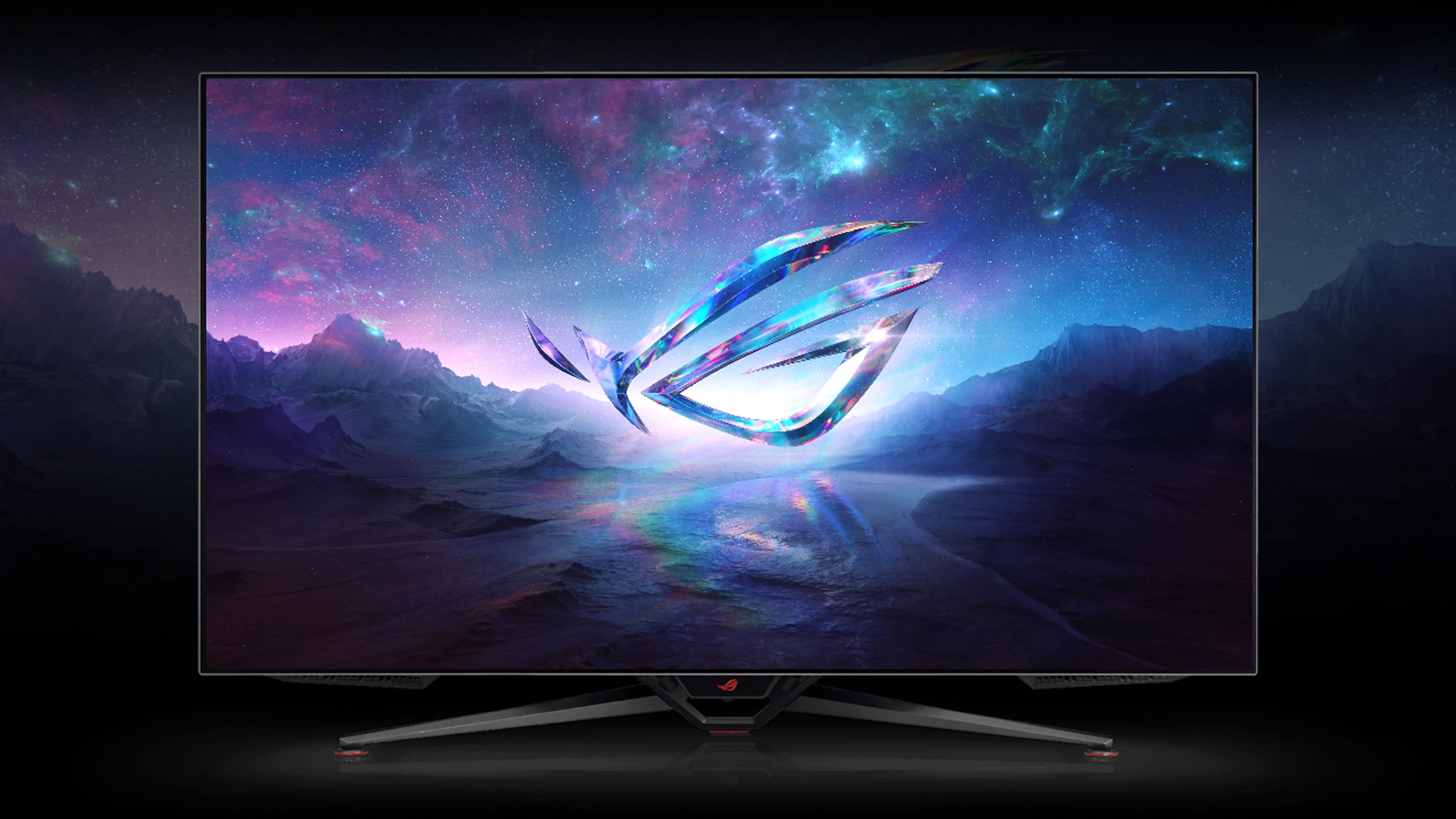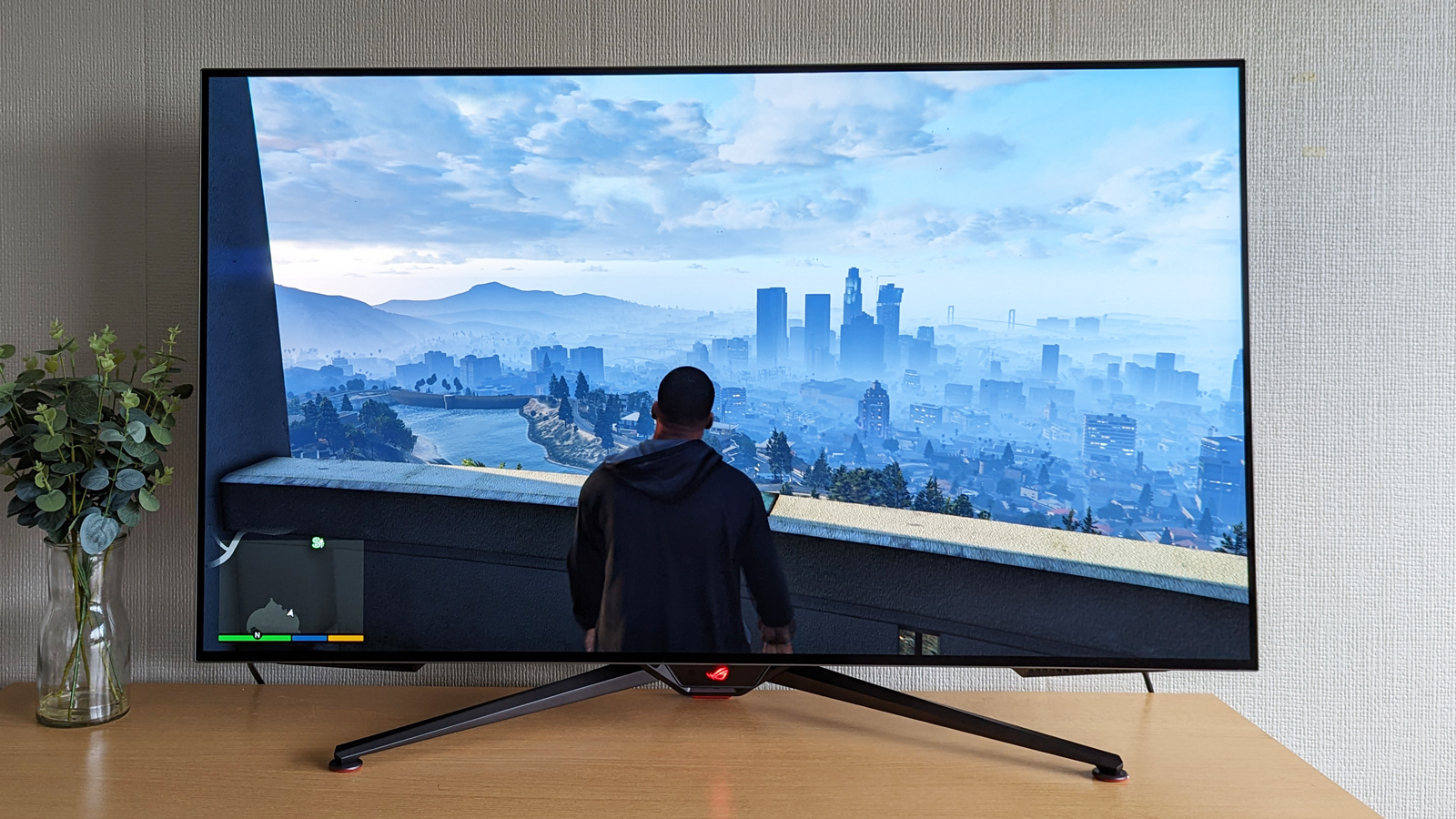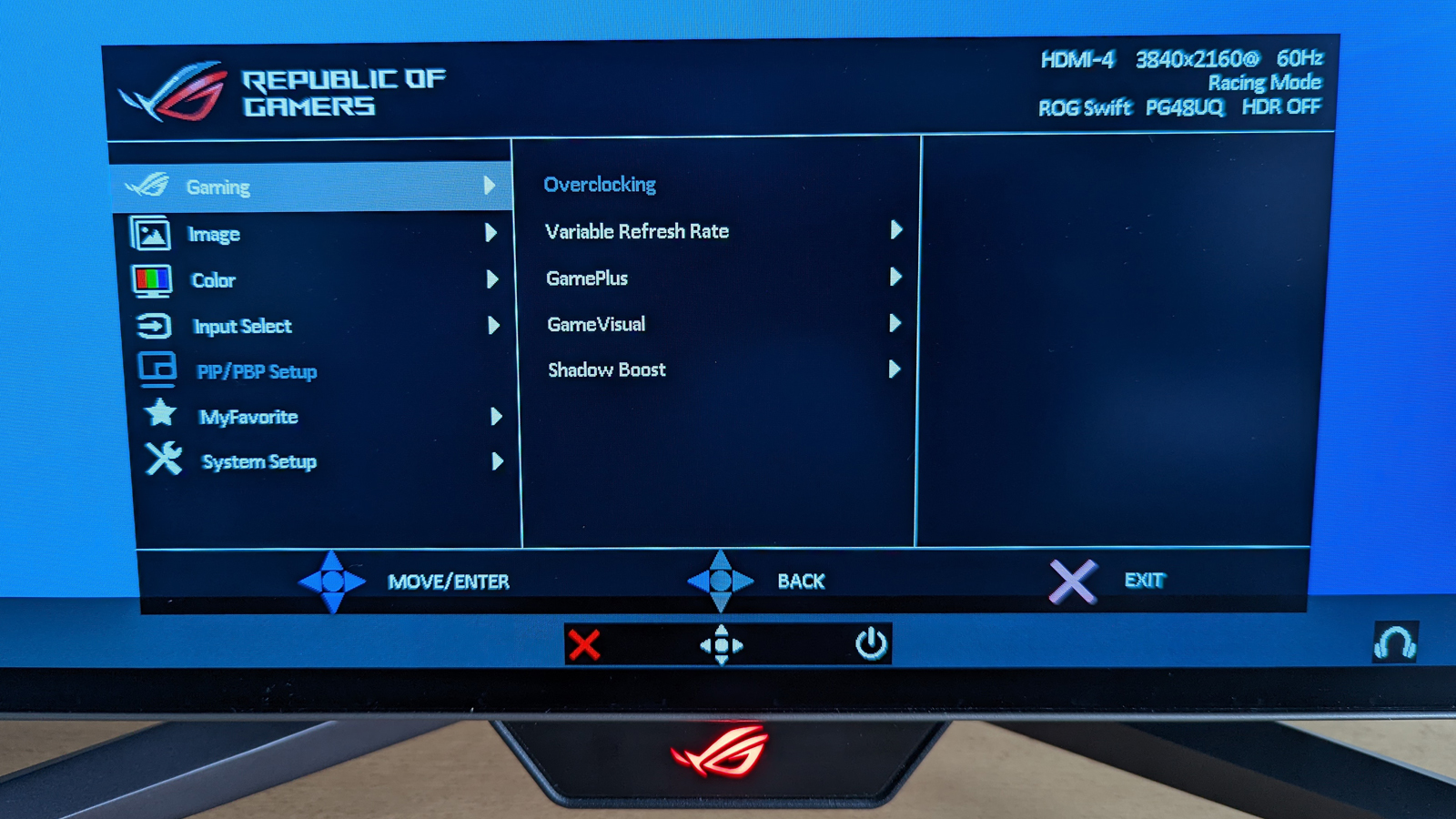Asus ROG Swift OLED PG48UQ review: an awesome huge screen for gaming enthusiasts
The Asus ROG Swift OLED PG48UQ blurs the lines between monitor and TV


The Asus ROG Swift OLED PG48UQ isn't going to be the gaming monitor for everyone – not least because of its huge 48-inch size – but in terms of the specs it offers and the picture you get, it's absolutely one of the best options out there for serious gamers at the moment.
-
+
Excellent gaming performance
-
+
Bright, high–contrast OLED tech
-
+
Gigantic size
-
-
Gigantic size
-
-
Not the easiest to set up
-
-
It'll cost you
Why you can trust T3

The Asus ROG Swift OLED PG48UQ is one of the more unusual contenders for our best gaming monitor list that we've seen lately: it measures a huge 48-inches from corner to corner for a start, so in many ways it's more like a TV set than a monitor.
Of course the lines between what a monitor is and what a TV is have become more and more blurred over time. Both categories have gradually become more like the other, and products like the Samsung M8 Smart Monitor now cover both bases pretty well.
In the Asus ROG Swift PG48UQ OLED review that follows, we'll tell you everything you need to know about this screen, from the quality of the picture to the number of ports you've got to play around with – so you should be able to decide if it's the right massive monitor purchase for you.
Asus ROG Swift OLED PG48UQ: price and availability
The Asus ROG Swift OLED PG48UQ is available to buy now: check the widgets on this page for the latest deals and the lowest prices on the web, but at the time of writing we're seeing prices of around £1,500 in the UK and $1,500 in the US.
If you're in the UK, the monitor is available from retailers including Amazon and Overclockers – just make sure you're choosing the one you want, because 42-inch and 48-inch models are available (it's the latter larger one we're reviewing here).
Asus ROG Swift OLED PG48UQ review: design and setup

There's no getting around it: the Asus ROG Swift OLED PG48UQ is a bit of a pain to set up, because of its gigantic size, a rather awkward stand design, and the fact you'll need to dig out an Allen key from somewhere. These are by no means major problems, but they're worth noting.
Remember you're going to need a serious amount of desk space, because we're talking about a 47.53-inch display panel here. If you tend to sit relatively close to the screen, maybe get the smaller version of this monitor. If you're measuring out a space for the 48-inch monitor, its footprint is 1068 (W) x 686 (T) x 266mm (D) and it weighs 16.2kgs.
Get all the latest news, reviews, deals and buying guides on gorgeous tech, home and active products from the T3 experts
One or two bumps in the assembly process aside, we like what Asus has done with the aesthetics here. There's no fancy lighting, just an illuminated red Republic of Gamers logo underneath (which you can turn off if you prefer). Under the logo is a joystick for controlling the on-screen menus, which work well enough and offer plenty of options to play around with.
As befits its almost-a-TV nature, there's no real flexibility here: this Asus ROG monitor doesn't rotate or tilt or let you adjust its height. While the panel itself is ultra-thin, the thickness comes from a chunky heatsink attached to the back, which should improve OLED performance and the longevity of the product. It also provides room for the ports, which are somewhat awkwardly placed, and you also get a tripod screw mount on top if you want to attach a camera for streaming. Oh, and there's a remote control in the box too.
The monitor is fitted with one DisplayPort 1.4, two HDMI 2.0, and two HDMI 2.1 ports, which is plenty. There's also a USB hub in the form of four USB 3.2 Gen 1 Type-A sockets, two around the back and two on the top.
As well as a SPDIF out socket and a 3.5mm headphone jack, there's also a 2.1 speaker system: two 10W stereo speakers with a 15W woofer. The audio isn't amazing, but it matches up with what we would expect from most TVs around this size, and we think the sound quality is good enough for most people.
Asus ROG Swift OLED PG48UQ review: specs and picture

It's hard not to be impressed by what the Asus ROG Swift OLED PG48UQ offers in terms of picture: we tested it with games, movies and everyday computing, and it's a stunner across the board in terms of how much it impressed us. The OLED tech helps here of course, with a 1,500,000:1 contrast ratio, a peak brightness of 900 nits, and HDR10 support all contributing to the overall picture. It all adds up to a panel that really catches the eye, provided you're sat a sensible distance away from it.
As for the other key stats you need to know about, you've got a 4K (3840 x 2160 pixel) resolution, up to a 138Hz refresh rate when overclocked (120Hz otherwise), and grey-to-grey response times that can go as low as 0.1 ms (when these rates are being pushed, that's when the heat sink really helps). Both Nvidia G-Sync and AMD FreeSync technologies are supported, as well as variable refresh rate (VRR), and Asus says that it's worked on custom configurations to improve text sharpness and keep brightness uniform across the screen.

For more professional work, there's 98 per cent coverage of the DCI-P3 colour gamut, 133 per cent sRGB coverage, and Delta E<2 colour support, as well as 10-bit colour depth – that adds to the appeal if you're going to be spending a significant amount of time on creative tasks where colour accuracy is important.
We should also mention the specially developed matte coating that Asus has added – which looks great and certainly helps with visibility – and the aspect ratio control that lets you put a 24-inch, 27-inch or 34-inch screen overlay in the middle of the monitor.
With pleasingly thin bezels around the sides of the panel, it's a superb overall package that we struggle to find fault with – it's simply a question of whether you want to spend this much for something this big. It's also fair to say that you can find monitors that beat it in terms of refresh rate and pixel density, so you need to ask yourself how important that OLED technology is to you. There are a lot of top-quality gaming monitors around at the moment, which is both good news and bad news when it comes to finding the particular model that's right for you.
Asus ROG Swift OLED PG48UQ review: verdict

OLED technology is of course now commonplace when it comes to televisions and smartphones, and we're finally starting to see it make an appearance on gaming monitors as well – though there still aren't very many of them around. If you absolutely have to go OLED for its inky blacks and perfect backlighting, then the Asus ROG Swift OLED PG48UQ is one of the best picks you can make, especially at this size (it's only really LG that has anything directly comparable to the 48-inch model that we've reviewed here).
Without the dimming zones you get with LCD screens, you're looking at pixel-perfect lighting from this Asus ROG display, and it does make a difference when you're gaming and watching video content. We also like a lot of the custom touches that Asus has added, whether that's the bespoke heat sink, the USB hub for your peripherals, the anti-glare coating, or the remote control that's bundled in the box. Most of the choices make sense, and it ticks pretty much all the boxes when it comes to a gaming screen (except perhaps for Dolby Vision).
The Asus ROG Swift OLED PG48UQ isn't just up against other monitors though, it's also up against other OLED TVs, especially when it comes to console gaming – that means you need to cast your net wider when you're doing your research. It's not a particularly easy monitor to assemble, and of course the sheer size of this device means it's not going to be the right choice for everyone (for a start you need to figure out if you have a desk deep enough to make it worthwhile).
Overall, when it comes to choosing one of the best 4K monitors you can buy, we'd absolutely recommend keeping this particular model in mind. We didn't notice anything in the way of screen tearing or stuttering during our time with it, it excels at everything from fast-paced games to text editing (with impressive clarity for individual pixels), and you've got a bunch of input ports and on-screen options to pick from. All this tech will cost you, as you'd expect, but considering the specs on offer here we don't think that the asking price is especially exorbitant.
Also consider
If you absolutely want the OLED technology for your next gaming monitor, then the Alienware AW3423DW is an obvious alternative to the monitor we've reviewed here – at 34 inches it's significantly smaller, but you might well be fine with that. It's also curved, which will suit some people better, and it'll cost you less as well. What you don't get on the Alienware model is the 4K resolution, and the aspect ratio is significantly wider at 21:9, so you need to take all of that into consideration when making your choice.
If you absolutely want to go big but aren't too concerned about whether that's with OLED or LCD technology, then the Samsung Odyssey Neo G9 has to be in the conversation: the panel measures 49-inches from corner to corner (with a 5120 x 1440 pixel resolution), and has a curved form factor with a 32:9 aspect ratio. It really is an immersive experience and it beats the Asus ROG Swift PG48UQ OLED in terms of refresh rate, going all the way up to 240Hz. It'll cost you even more than the Asus monitor though.
Dave has over 20 years' experience in the tech journalism industry, covering hardware and software across mobile, computing, smart home, home entertainment, wearables, gaming and the web – you can find his writing online, in print, and even in the occasional scientific paper, across major tech titles like T3, TechRadar, Gizmodo and Wired. Outside of work, he enjoys long walks in the countryside, skiing down mountains, watching football matches (as long as his team is winning) and keeping up with the latest movies.
